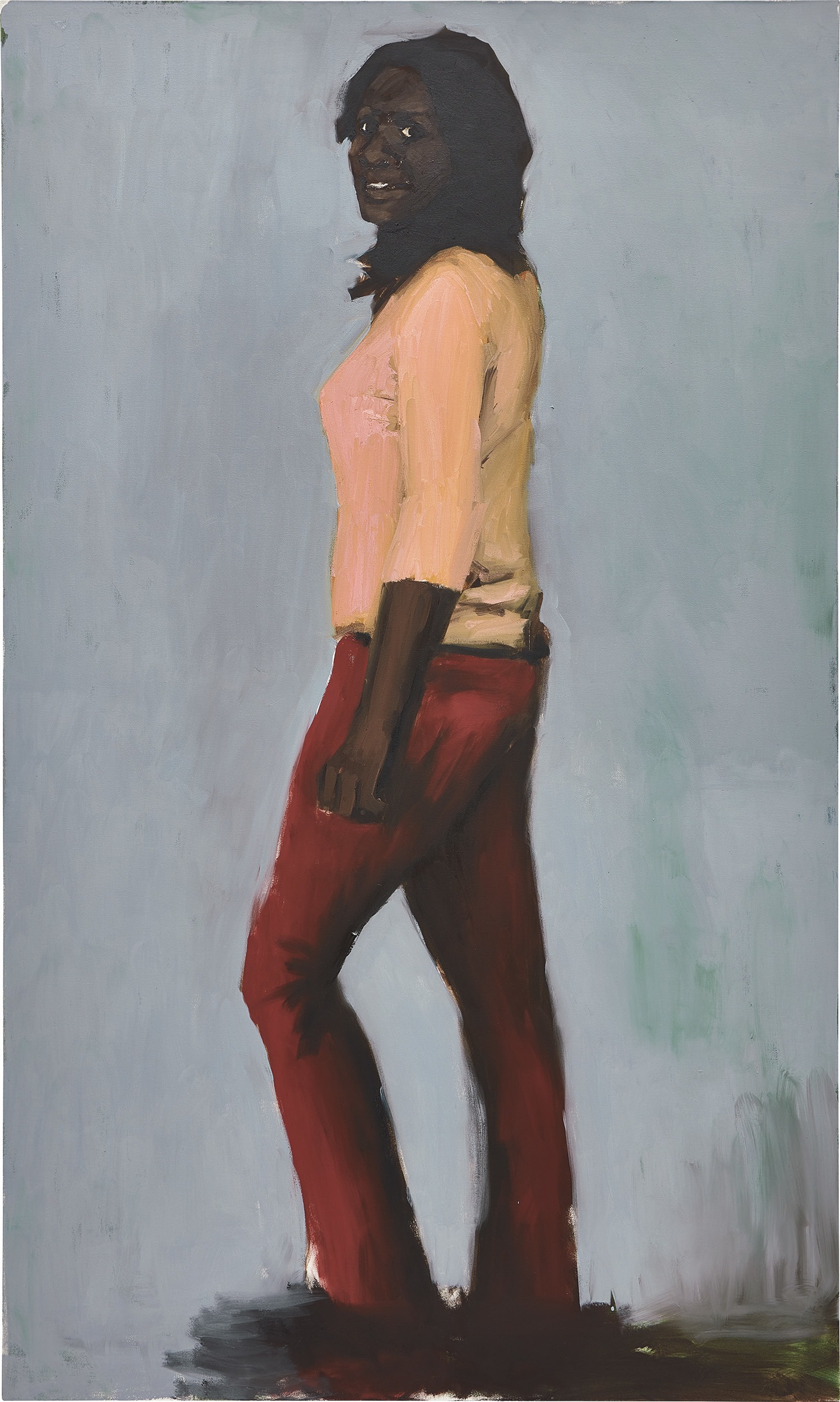

2
Lynette Yiadom-Boakye
Marble
Full-Cataloguing
Unlike the named sitters typically depicted in traditional European portraiture, Yiadom-Boakye’s characters are fictive, indistinct from a specific time and place. Differing from the paintings of society portraitists, such as Thomas Gainsborough, Yiadom-Boakye figures are ‘suggestions of people…They don’t share our concerns or anxieties. They are somewhere else altogether’ (Lynette Yiadom-Boakye, quoted in Nadine Rubin Nathan, ‘Lynette Yiadom-Boakye’s Fashionable Eye’, The New York Times Magazine, 15 November 2010, online). Displaced from specific or symbolic settings, the portrait is stripped of staged grandeur; the female protagonist in Marble is set against an indeterminate backdrop, void of visual associative connotations. Composed and at ease, Yiadom-Boakye figures are often naturally portrayed, whether running an errand, enjoying a coffee, conversing with one another or sitting en repos. Functioning as ‘portraits of society’ rather than of individuals’ (Orlando Reade, ‘Life Outside the Manet Paradise Resort. On The Paintings of Lynette Yiadom-Boakye’, The White Review, November 2012, online), Yiadom-Boakye’s figures are charismatic yet calm, dislocated from space and specificity. It is this indeterminacy which allows Yiadom-Boakye’s paintings to function as visual snapshots, offering a momentary view into the life of the fictional sitter.
Commenting on her practice, Yiadom-Boakye states, ‘People are tempted to politicize the fact that I paint black figures, and the complexity of this is an essential part of the work. But my starting point is always the language of painting itself and how that relates to the subject matter.’ (Yiadom-Boakye, quoted in Hans Ulrich Obrist, ‘Lynette Yiadom-Boakye interview by Hans Ulrich Obrist,’ Kaleidoscope, no. 15, 2012, p. 102). Primarily interested in the techniques of oil painting, Yiadom-Boakye’s painterly output is demonstrative of her ability to command paint, creating moments of sublimity on canvas. Weaving threads of art history into her works, echoes of Michelangelo Merisi da Caravaggio and Rembrandt Harmenszoon van Rijn are visible in her luxuriously painted fabrics and soft chiaroscuro echoes. Yiadom-Boakye’s exploration of tone and, particularly, the colour red is evident in the present work through the rich rouge coloured trousers of the figure, creating a sense of statuesque drama against the cooler background. Studying painting and exposed to the titans of the art historical canon, the artist regularly views pivotal paintings at the National Gallery, in particular, Edgar Degas’ painting La Coiffure. Commenting on the painting, Yiadom-Boakye’ states that it stands as ‘a reminder that it is possible to achieve movement, elegance, heat, and brutality with very little and that it doesn’t need to look real to feel it. Feeling rather than knowing. Feeling as believing. Painting as sensuality’ (Lynette Yiadom-Boakye, quoted in Jennifer Higgie, ‘Don’t Explain’, Lynette Yiadom-Boakye, Munich, 2014, p. 9). Invoking scarlet tones, Yiadom-Boakye’s mastery of red was honed by revisiting Degas’ treatment of the colour, commenting, ‘I’ve also learnt about red from this painting: how to make it work. And that it is possible to lay scarlet next to orange, next to deep cadmium red, next to pink, next to black and bring the whole thing to life with a few patches of bare canvas and white’ (Lynette Yiadom-Boakye, quoted in ‘Artists’ Artists’, Frieze.com, 1 October 2012, online).
Showcasing her skilled command of the brush to convey complex light play on the arm, face and clothes of her protagonist, the present work offers an insight into a fleeting and transient moment, shared between viewer and the artist’s fictive character. Exploring poetry and language within her practice, Yiadom-Boakye names her paintings with ambiguous titles, creating a sense of lyricism in her canvases. In the present work, Marble, the artist evokes connotations of ancient Greek sculpture, her figure standing both proudly and naturally at the centre of the composition. As noted by Zadie Smith, ‘her titles run parallel to the images … the canvas is the text’ (quoted in Zadie Smith, ‘Lynette Yiadom-Boakye’s Imaginary Portraits’, The New Yorker, 19 June 2017, online). Like a modern muse, Yiadom-Boakye's centrally poised figure offers a new remodeling of classical notions and tropes within art history.
Lynette Yiadom-Boakye
British | 1977Lynette Yiadom-Boakye is a British painter who is a leader in the contemporary renaissance of portraiture. Her subjects are typically depicted with loose brushwork, floating against muted, ambiguous backgrounds that contribute to a sense of timelessness. Known for the speed of her work, she often completes a canvas in a single day and considers the physical properties of paint to be at the core of her practice.
Yiadom-Boakye was born to Ghanaian parents in London, where she continues to live and work today. In 2013, she was a finalist for the Turner Prize and she was selected for participation in the 55th Venice Biennale. In 2018, the artist won the Carnegie Prize for painting. Her work can be found in the permanent collections at the Victoria & Albert Museum, the Studio Museum and the San Francisco Museum of Modern Art, among many others.